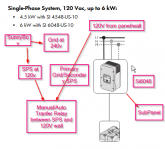Ah. Yup to backfeed you would want a sunny boy(s) (microinverters?), transformer, web box, cards and comm cables.
And this is for everybody here...... if you want to just know directly, what you need from a manufacturer to get their tech up and running, call them and ask. They want to sell and understand thet instlers amd users will need to know more.
Unfortunately for some, the details are likely in the manual. Start with the warnings and glossary of terms. Then the overview and system operation details.
Its usually in there, but if you are really not speaking the language (toughest barrier) a talk with a rep or applications engineer is in order before buying.
Next talk to the outlet you buy from, as the same general questions with your new knowledge in pocket. I sometimes glean really great info from unlikley salesmen resources..... but usually not precise details. You can rarely ask these people "what do i need" and the engineers will want to know what youn are looking at and what you need it to do.
With sma, call them and give them your model and serial data and simply ask them what parts are needed in your case.
Diversion loads and or remote operated breakers* might be integrated in order to accomplish with grace though.





